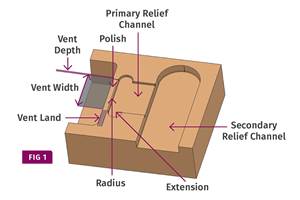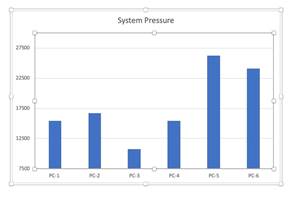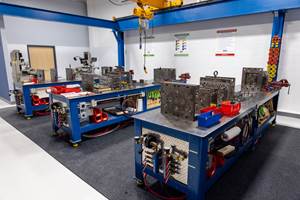Maintenance Terms of Endearment
Tooling Know How
Look closely at your company’s mold maintenance language and formalize your approach to create a clear and concise picture—one that can be measured.
At a recent meeting of the American Mold Builders Association in Chicago, Troy Nix, the group’s executive director, presented the results of a poll in which 115 molders of various products were asked to identify the top challenges their management teams will face over the next 12 months. More than 300 responses to this question revealed two top issues:
Number one (cited by 45% of respondents): Workforce development (finding talent, training, developing technical skills.
Number two (36% of respondents): Seeking operational excellence (lean manufacturing, waste reduction, zero defects, higher throughput, continuous improvement, scrap reduction, efficiency improvement, improving profits, etc.).
So 81% of those polled need higher-skilled help and more efficient systems in which to cultivate and utilize these skills. This is not news to anyone involved in mold maintenance. At our training center, we always have someone asking if we “know anyone” skilled in mold repair or someone with tooling repair experience. As baby boomers fade into the sunset, their skills and knowledge are not being replaced nearly fast enough by a new generation of maintenance personnel coming into this challenging field.
How does a mold maintenance manager develop a workforce that historically has been trained on the job by its “best guy,” who is now in the final phase of his working life? How does a company even know that its “best guy” is performing at a standard industry “best practice” level? They know by starting at the beginning.
Skills Training Techniques
With skills training in anything mechanical, some specifics must be understood. We must know what our job is—from a 30,000-ft overview down to the type, location, amount, and frequency of the grease we apply to our molds. Knowing all this effectively requires a trainee to learn mold character nuances involving hundreds of variables. Historically, understanding these variables happens through on-the- job (OJT) training and informal repair “stories” that are scribbled onto typical work-order forms. This won’t work in today’s maintenance environment, where the focus is on operational excellence (OE). OE is not attained by following the most senior technician around the shop to learn what he knows. OE is attained by working in a structured system with standardized and documented techniques that are measureable in order to verify whether they provide real value or just smoke and mirrors.
Take, for example, the maintenance job description. What does the mold repair department do? What is the reason for its existence? In a nutshell, the toolroom supports molding and other departments to “efficiently produce quality parts on time.”
Success lies in a toolroom’s ability to create proactive tasks and standardized corrective actions to reduce or eliminate mold and part defects. This is the only logical path to make continuous improvements in mold performance and shop efficiency.
The term “proactive” is a bit of a stretch from the historical job description of “just fix it,” which refers to the proverbial maintenance band-aid for “making it run.”
Moving away from this culture means we need to work smarter. It’s not a new concept, but it’s one that’s difficult to implement when we work in a world of maintenance “stories” versus real, measureable data. Specifically, this means we need to understand everything we possibly can about the variables that contribute to part defects, poor mold performance, and tedious/ laborious maintenance procedures.
In order to better understand and measure what we do all day as repair technicians, it is important—no, it’s absolutely necessary—to resist the temptation to speak or document in broad terms when it comes to the language of mold maintenance. Identification of an issue is step one.
Use Mold Maintenance Terms, Not Stories
Moving away from maintenance stories starts with using consis-tent terms to shorten documentation time and improve clarification. Using terms can sometimes be difficult when there are so many that mean the same thing. Standardizing our maintenance language is more important than the “industry correctness” of the term. For example: “A” side vs. “hot half” vs. “stationary side” or “top half,” etc. These are all terms for the same thing. Is it a leader pin or guide pin? Is it a horn pin or an angle pin? Is it a heel block or a wedge lock? Well, that depends on who you ask. The list is long. This fact makes it difficult to find a term that will paint the right picture of what someone needs to convey.
The important point is using the same term consistently vs. knowing the exact, proper definition of a term. Sure, it would be great if all repair techs used the same handbook when learning terms but that’s not the way it happens. Maintenance jargon is usually specific to a shop—and that’s OK—but don’t let the “correctness” of the term bog down the process of using it. If your maintenance software does not readily accept or use standard terms, then simply post a list by your PC that can be used in daily communication with a maintenance program.
If we can’t use standard terms for critical information, then we won’t measure anything, which is certain death to continuous-improvement ideology.
So in this world of maintenance subjectivity, see the accompanying illustration for a few terms that you should use routinely in daily data entries in conjunction with your mold-component terms when describing mold defects. They might not sound like much to the layman, but to a skilled troubleshooter they mean all the difference in the world.
All of these terms point to potential root causes when troubleshooting molds. When these descriptive terms are used consistently (the software used should offer drop-down menus that offer these choices), there is now a means by which to count them for a clearer understanding of where targets and goals should be set.
Also, by including these basic mechanical adjectives in your tooling defect descriptions, tooling issues will be more easily recognized for more accurate troubleshooting and root-cause analysis. It will also help you to more quickly identify areas of weakness that are high-cost (tooling and labor) or high-frequency (efficiency reduction).
Look closely at your company’s maintenance language and formalize your approach to create a clear and concise picture— one that can be measured. You will be surprised at the efficiency improvements that come from better communication.
Related Content
Back to Basics on Mold Venting (Part 2: Shape, Dimensions, Details)
Here’s how to get the most out of your stationary mold vents.
Read MoreHow to Achieve Simulation Success, Part 2: Material Characterization
Depending on whether or not your chosen material is in the simulation database — and sometimes even if it is — analysts will have some important choices to make and factors to be aware of. Learn them here.
Read MoreMPM’s Second Act: Keeping Injection Molding, Moldmaking in the Midwest
Larry Austin’s 35 years at a highly successful injection molding company inform much of what he does and doesn’t want in his second act in plastics owning an injection molding company.
Read MoreAmerican Injection Molding Institute Opens Mold Maintenance Classroom
The Beaumont subsidiary has opened the Mold Maintenance Center of Excellence classroom at its Erie, Pennsylvania, headquarters.
Read MoreRead Next
See Recyclers Close the Loop on Trade Show Production Scrap at NPE2024
A collaboration between show organizer PLASTICS, recycler CPR and size reduction experts WEIMA and Conair recovered and recycled all production scrap at NPE2024.
Read MoreFor PLASTICS' CEO Seaholm, NPE to Shine Light on Sustainability Successes
With advocacy, communication and sustainability as three main pillars, Seaholm leads a trade association to NPE that ‘is more active today than we have ever been.’
Read More











